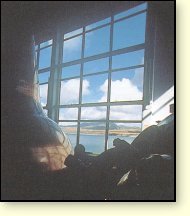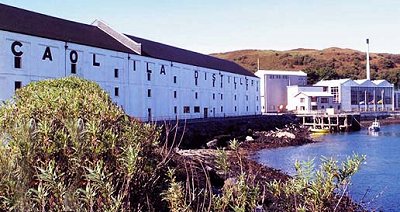Caol Ila – “the Sound of Islay” on whose shore it stands!
 A ROOM WITH A VIEW
A ROOM WITH A VIEW
The Caol Ila distillery is tucked in the lee of a hill on the seashore by the ferry from Jura and you look over to the famous Paps of Jura rearing on the far hinterland. Caol Ila is not a pretty distillery by any stretch of the imagination, but the view outwards from it is exhilarating. The still house is glass-fronted and these shapely mountains are always in view as the still house staff go about their daily work.
ORIGINS
Caol Ila dates from 1846 and was built at this lovely but remote spot by Hector Henderson who had business connections with Littlemill (Lowlands) and some now long-defunct Campbeltown distilleries. It was bought by the owner of the Isle of Jura distillery in 1852.

THE MODERN ERA
Caol Ila continues to produce up to the present day with short periods of closure from 1930 to 1937 (under new owners DCL) and during World War II.
In the early 1970s, the distillery was largely rebuilt, the stark functional structure that makes you wince when you first glimpse it from the ferry, save for a massive warehouse. The old buildings from 1846 were levelled and new ones erected in a contemporary shoe-box like design, more or less shared with the then brand new Clynelish distillery. While Caol Ila was closed, the old Clynelish distillery, renamed Brora, filled in by producing a heavily peated new make, in order to safeguard supplies for future blends. Some of the casks of spirit from Caol Ila are matured in the warehouses of the old Lochindaal distillery near Port Charlotte, which was closed in 1929.
A BLENDING MALT
While the buildings may lack that romantic character (the 1st Islay distillery to be made of concrete in the 1800s) often associated with malt whisky distilleries, the spirit produced on the site more than compensates for it. Caol Ila has eight 60,000 litre wooden washbacks, where the peaty wash is fermented for at least 80 hours. The six stills are copies of the old ones, traditionally onion shaped, with wide necks and long, downward sloping lyne arms. The wash stills hold around 35,000 litres, and the spirit stills some 29,500 litres. However, the charges are only around a third to half of the full volume of the stills. This increases the reflux action, as the top part of the kettle of the pot still practically forms a section of the neck. Shell and tube condensers are used to condense the spirit vapours into liquid.
Caol Ila boasts the largest output of any of the Islay distilleries, but almost all of the production is used for blending purposes. Such is the quality of the spirit that it in addition to the usual heavily peated version, an unpeated ‘Highland’ style is also produced, and this is now available as an eight-year-old expression from Diageo.
THE SINGLE MALT
Although the large, original warehouse remains on site, very little Caol Ila whisky is matured on Islay. Most of it is tankered away as new make, to be filled into casks and then matured in the Central Belt of Scotland. It is therefore highly unlikely that any Caol Ila whisky has spent more than a few days on Islay. The olive-like, briny, fruity and often intense character will clearly not have much to do with the coastal location of the distillery itself. Caol Ila is, nonetheless, very distinctly an Islay whisky.
The independent bottlers have long recognised the quality of Caol Ila, despite its huge output, and surely, Diageo’s blenders will also know its worth? But the marketing department has insisted that the largest Islay distillery was a malt to be hidden from the market. Were they scared to negotiate that last, steep slope down to the distillery? Now however, given the current bullish drive for peaty whiskies, even the marketing department has woken up, as it has only recently become available as a bottled malt with a very limited distribution.
Text from The Whisky Trails, Copyright © Gordon Brown 1993; The Whisky-Pages, Copyright © Par Caldenby 2006; Edited by R.P. McMurray, Copyright © 2007


